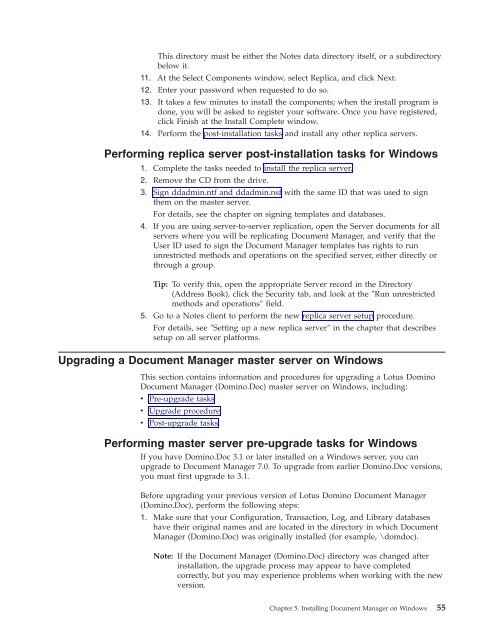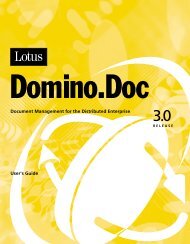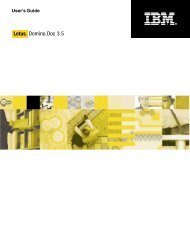Domino Document Manager - Lotus documentation
Domino Document Manager - Lotus documentation
Domino Document Manager - Lotus documentation
You also want an ePaper? Increase the reach of your titles
YUMPU automatically turns print PDFs into web optimized ePapers that Google loves.
This directory must be either the Notes data directory itself, or a subdirectory<br />
below it.<br />
11. At the Select Components window, select Replica, and click Next.<br />
12. Enter your password when requested to do so.<br />
13. It takes a few minutes to install the components; when the install program is<br />
done, you will be asked to register your software. Once you have registered,<br />
click Finish at the Install Complete window.<br />
14. Perform the post-installation tasks and install any other replica servers.<br />
Performing replica server post-installation tasks for Windows<br />
1. Complete the tasks needed to install the replica server.<br />
2. Remove the CD from the drive.<br />
3. Sign ddadmin.ntf and ddadmin.nsf with the same ID that was used to sign<br />
them on the master server.<br />
For details, see the chapter on signing templates and databases.<br />
4. If you are using server-to-server replication, open the Server documents for all<br />
servers where you will be replicating <strong>Document</strong> <strong>Manager</strong>, and verify that the<br />
User ID used to sign the <strong>Document</strong> <strong>Manager</strong> templates has rights to run<br />
unrestricted methods and operations on the specified server, either directly or<br />
through a group.<br />
Tip: To verify this, open the appropriate Server record in the Directory<br />
(Address Book), click the Security tab, and look at the ″Run unrestricted<br />
methods and operations″ field.<br />
5. Go to a Notes client to perform the new replica server setup procedure.<br />
For details, see ″Setting up a new replica server″ in the chapter that describes<br />
setup on all server platforms.<br />
Upgrading a <strong>Document</strong> <strong>Manager</strong> master server on Windows<br />
This section contains information and procedures for upgrading a <strong>Lotus</strong> <strong>Domino</strong><br />
<strong>Document</strong> <strong>Manager</strong> (<strong>Domino</strong>.Doc) master server on Windows, including:<br />
v Pre-upgrade tasks<br />
v Upgrade procedure<br />
v Post-upgrade tasks<br />
Performing master server pre-upgrade tasks for Windows<br />
If you have <strong>Domino</strong>.Doc 3.1 or later installed on a Windows server, you can<br />
upgrade to <strong>Document</strong> <strong>Manager</strong> 7.0. To upgrade from earlier <strong>Domino</strong>.Doc versions,<br />
you must first upgrade to 3.1.<br />
Before upgrading your previous version of <strong>Lotus</strong> <strong>Domino</strong> <strong>Document</strong> <strong>Manager</strong><br />
(<strong>Domino</strong>.Doc), perform the following steps:<br />
1. Make sure that your Configuration, Transaction, Log, and Library databases<br />
have their original names and are located in the directory in which <strong>Document</strong><br />
<strong>Manager</strong> (<strong>Domino</strong>.Doc) was originally installed (for example, \domdoc).<br />
Note: If the <strong>Document</strong> <strong>Manager</strong> (<strong>Domino</strong>.Doc) directory was changed after<br />
installation, the upgrade process may appear to have completed<br />
correctly, but you may experience problems when working with the new<br />
version.<br />
Chapter 5. Installing <strong>Document</strong> <strong>Manager</strong> on Windows 55












